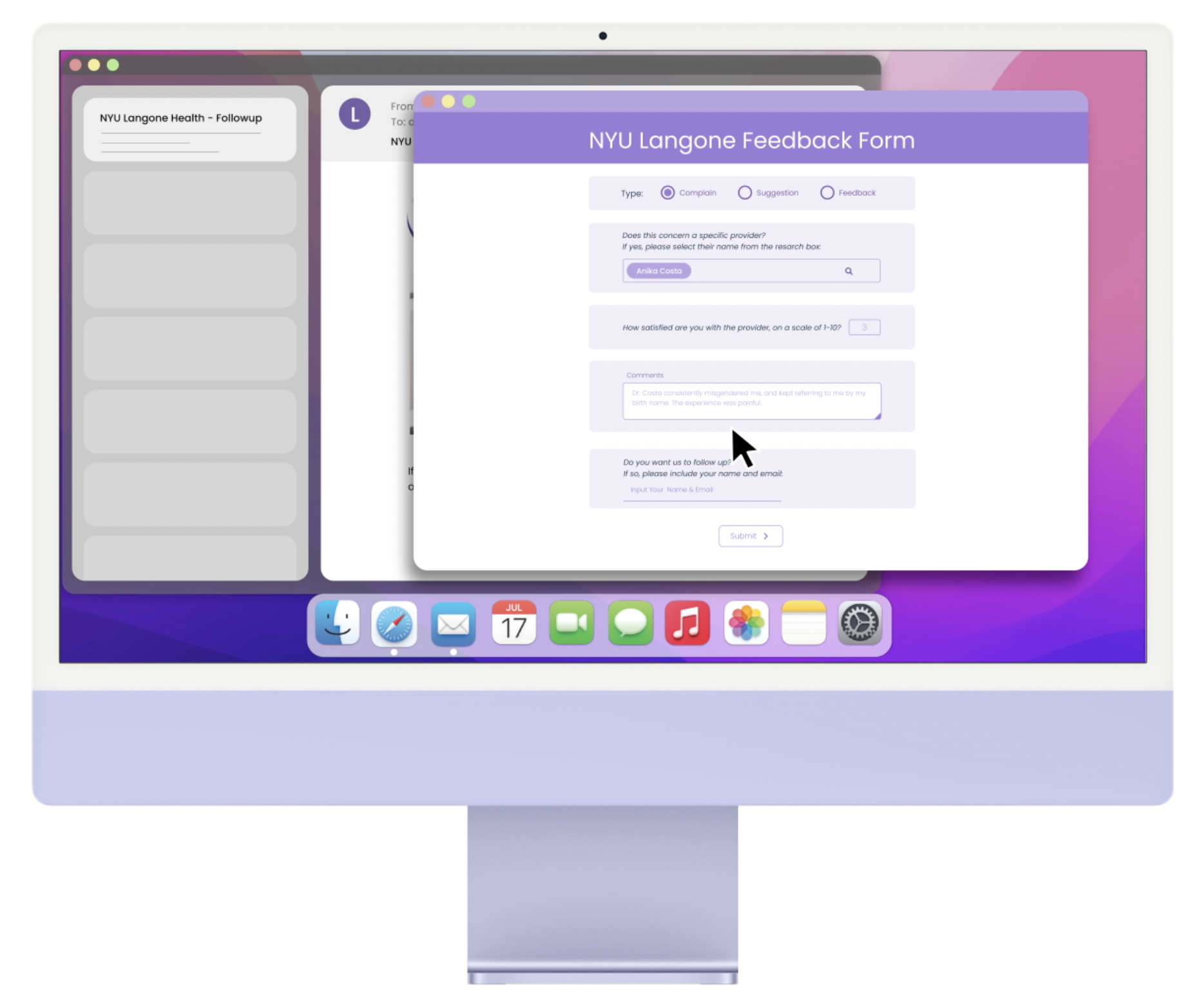Building trust between gender expansive patients and medical providers
✨ NYU Langone Health selected our work to feature in their Innovation Lab ✨ Our ideas will be used to shape future infrastructure and make Langone more gender expansive friendly!

Overview
Client
The FuturePractice Lab within the NYU Langone Health system is a research and development team of clinicians, designers, engineers, and researchers, focused on improving the healthcare experience.
Context
The lab consulted us students to make Langone more friendly to the gender expansive community. We had 5 weeks to research, ideate, prototype, gather feedback, and present our solutions.
-
“An umbrella term sometimes used to describe people who expand notions of gender expression and identity beyond perceived or expected societal gender norms. Some gender-expansive individuals identify as a mix of genders, some identify more binarily as a man or a woman, and some identify as no gender” - PFLAG
Role - Team Lead
Prototype internal metrics view
Gauge progress and morale
Lead meetings with agenda and minutes
Delegate tasks and deadlines
Establish creative direction
Skills Learned
-
Coming from different skillsets, languages, and cultures, we all had varied viewpoints. I learned how to create a safe space where teammates could earnestly share their ideas and feel confident presenting them to stakeholders.
-
I learned how to use Adobe XD, Figma, and Sketch to create mockups, and elevated my Adobe After Effects skills to make a professional looking UI walkthrough.
-
Performing has always been my forte, but I’ve never had to defend my ideas in front of a crowd. This was an eye opening experience. Turns out I’m good at turning feedback into solutions, and responding with confidence!
Problem Statement
How might NYULH improve its patient experience to be more inclusive, supportive and positive for people who are transgender, nonbinary and genderqueer?

Research
We used surveys and interviews to get first hand provider and patient accounts, conducted literature reviews, and explored the existing infrastructure at Langone.
Summary
Gender expansive patients distrust medical institutions
experience an unequal power dynamic with providers
unable to advocate for themselves and share their experiences
Patients need sound medical advice from trusted and legitimate sources
Providers need organized infrastructure to respond to concerns and educate patients
Existing Infrastructure
-
The Langone MyHealth app allows patients to access their medical record, contact a doctor, and do virtual checkups. However, it is not tailored specifically to gender minorities. The webpages listed above are much more pertinent.
-
Langone Health has an LGBTQ+ Patient Relations Team that queer patients can email or call with questions and concerns.
There's also a Transgender Health webpage that highlights providers who tend to transgender patients and provide hormone therapy and affirmation surgery.

Five interviews
We gathered first person experiences by interviewing clinicians, patients, and administrative staff:


Literature Review
Here’s what we found in peer reviewed research, newspaper articles, and journals:
-
Transgender People Face Huge Barriers to Healthcare - Lisa L. Gill, Consumer Reports, 2020
“Trust of the medical system is so low that ‘many lesbian, gay, bisexual, and transgender individuals are not out to their providers.’”
“Almost a third of transgender adults reported being harassed or denied care by a medical professional in 2015”
-
Providing Competent and Affirming Services for Transgender and Gender Nonconforming Older Adults - Porter et. al, 2016
“Half of transgender or gender nonconforming people have had to teach their doctors about trans healthcare, noting that ‘This is not surprising when one-third of medical schools in the United States and Canada surveyed require no clinical hours on LGBT health curricula.’”
-
Sexual and Gender Minority Health: What We Know and What Needs to Be Done - Mayer et. al, American Public Health Association
queer patients are hesitant to disclose identity when receiving medical care
many providers are incompetent in LGBTQ+ issues
structural barriers impede access to health insurance and medical decision making rights for queer people and their partners
lack of culturally appropriate harm reduction services.
Lastly, I found a clinical guidebook, Lesbian, Gay, Bisexual, and Transgender Healthcare, by Kristen Eckstrand and Jesse M. Ehrenfeld (2016) in the Springer Journal. It contained these incredibly helpful pointers:
Identify advocates (internal + external) with contact info
Celebrate LGBTQ+ holidays
Create an LGBTQ+ club and conduct SafeZone work shops
Display queer health materials
Include queer people in nondiscrimination policies

Survey Design
We asked questions to gauge the age group, gender identity, experiences with healthcare, and information sources from the gender expansive community. We aimed to keep it short, to encourage people to complete the form. If they were comfortable, we asked for contact information.
Distribution
On our respective social media apps, we linked the survey and posted promo videos to get people in our network to fill out the survey and share their experiences as gender queer people.
Results
Patients often distrust or fear certain providers
Bias and discrimination impact the quality of care
Often get misgendered
Personas
Goals
Promote friendly resources + providers
Provide medically sound advice
Allow patients to share feedback
Solution
Patient-Provider Feedback System
Feedback gathered from patients is reviewed by the Patient Relations Team in a ticketing system implemented with Zendesk, or similar software. Offending physicians are referred to administration. Outstanding providers are highlighted on a dedicated public dashboard, so the gender expansive community can make informed decisions.
Prototypes
We split the prototype amongst ourselves (see caption for attribution). I harmonized everything into one cohesive aesthetic, and created this high fidelity demo:
Patient Survey
Patient sees a QR code on a poster in the hospital. They can scan to access a survey.
2. The user can fill out the survey on their mobile phone.
3. Alternatively, a patient can access the survey in a followup email at home.
4. If a patient prefers a physical form, they can locate a drop off box which prints out a survey with a unique barcode. When a patient fills out the form and places it in the drop off slit, the form is automatically scanned into the Zendesk system.
Internal Ticket View
5. Members of the LGBTQ+ Patient Relations Team can see all the surveys in one place
6. Here’s a single ticket view. The Patient Relations Team can see the subject and contact information of the patient, along with the physician in question
6. Within the single ticket view, the Patient Relations Team can respond to the patient
Administration View
7. The administration can view specific complaints about all healthcare providers in the system. Here’s an example of a poorly performing doctor
8. Here’s a high performing doctor. They’ve earned a Highly Inclusive badge which will be shared to the community on the public facing dashboard
Public Facing Website
To maintain privacy of all physicians at Langone, we decided only to highlight well reviewed physicians, so the gender expansive community can select the best provider for their needs
9. The website will show all the top rated healthcare providers, using ratings collected from patient surveys. This brings the data back to the community
10. A patient looking for a provider at Langone can see details of each physician, including Highly Inclusive badges, patient ratings, and testimonials
Promotional Campaign
11. Finally, a speaker series to inform the public and Langone staff can be organized. Resources can be promoted with posters like these, distributed across the health system
Final Demo Video
Here’s the UI demo that I talked through in our presentation:
Gathering Feedback
In our fifth and final week, we iterated over our presentation to ensure that it fit within the allotted 15 minute time slot. We were able to share our solution with the NYU Langone FuturePractice Lab, and we got overwhelmingly positive feedback!
Here’s a screenshot of our Zoom recorded final presentation.
Impact
Our service design closes the communication loop between patient, provider, hospital system, and the greater gender expansive community
Easy to implement using existing Patient Relations Team and Zendesk services
Physical posters and brochures would publicize Langone’s gender inclusivity
The panel loved my walkthrough video. They said that it made the solution feel real and actually feasible.
Challenges
difficult to identify a stakeholder to design for since the prompt was so open ended
Researching both patients and providers allowed us to realize that both ends could use a communication solution.
Making sure my team was focused and motivated was always top of mind. I
made sure to send encouraging messages in our group chat, individually reach out to people to see their progress and morale, and ask them how I was doing as the leader.
Future Improvements
Given more time, I’d like to flesh out more of the analog and social media campaign material to promote Langone’s gender inclusivity efforts:
TikTok and Instagram content
Information brochures placed in all waiting rooms
Posters in hallways
I’d also invest more time into the final information visualization dashboard. I’d include more metrics about the physicians, allow patients to directly add feedback to the individual physician webpage instead of going through the surveys, and establish a way to vet comments to make sure they’re respectful and pertinent.

























